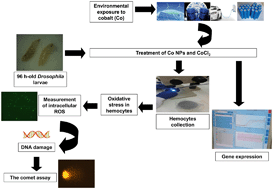当前位置:
X-MOL 学术
›
Environ. Sci.: Nano
›
论文详情
Our official English website, www.x-mol.net, welcomes your feedback! (Note: you will need to create a separate account there.)
In vivo evaluation of the toxic and genotoxic effects of exposure to cobalt nanoparticles using Drosophila melanogaster
Environmental Science: Nano ( IF 7.3 ) Pub Date : 2019/12/20 , DOI: 10.1039/c9en00690g Mohamed Alaraby 1, 2, 3, 4, 5 , Esref Demir 1, 2, 3, 4, 5 , Josefa Domenech 1, 2, 3, 4, 5 , Antonia Velázquez 1, 2, 3, 4, 5 , Alba Hernández 1, 2, 3, 4, 5 , Ricard Marcos 1, 2, 3, 4, 5
Environmental Science: Nano ( IF 7.3 ) Pub Date : 2019/12/20 , DOI: 10.1039/c9en00690g Mohamed Alaraby 1, 2, 3, 4, 5 , Esref Demir 1, 2, 3, 4, 5 , Josefa Domenech 1, 2, 3, 4, 5 , Antonia Velázquez 1, 2, 3, 4, 5 , Alba Hernández 1, 2, 3, 4, 5 , Ricard Marcos 1, 2, 3, 4, 5
Affiliation

|
Nanomaterials in general and cobalt nanoparticles (CoNPs) in particular are of great interest not only because of their multiple applications and environmental impact, but also for their potential toxicity and safety issues. Since most of the mechanisms involved in the toxicity of CoNPs are not very well known, mainly in vivo, we used Drosophila melanogaster as a simple and reliable in vivo model to investigate some toxicity-involved mechanisms. Thus, several toxicity-related approaches are used in this study including physicochemical characterization, viability, internalization, intracellular oxidative stress, and DNA damage (comet assay). In addition, changes in the expression of genes involved in general stress and antioxidant response, as well as in DNA repair response were evaluated, to better understand the underlying molecular mechanisms. The effects of CoNPs were compared with those induced by cobalt chloride (CoCl2), as a model ion releasing agent, to determine the role of the nanosized shapes in the observed responses. The obtained results indicate that ingested CoNPs translocate through the intestinal barrier of Drosophila larvae affecting hemolymph cells. Hemocytes, as targeted cells, show higher levels of intracellular reactive oxygen species (ROS) after CoCl2 exposure, but lower levels of DNA damage, in comparison with those induced by CoNPs. In addition, different genes showed an altered expression pattern, accordingly, if larvae were exposed to CoCl2 or to CoNPs. Subsequently, the effects induced by CoNPs cannot be associated only with their chemical nature.
中文翻译:

使用果蝇(Drosophila melanogaster)对暴露于钴纳米颗粒的毒性和遗传毒性的体内评估
普通的纳米材料,尤其是钴纳米颗粒(CoNPs),不仅因为其广泛的应用和对环境的影响,还因为其潜在的毒性和安全性问题,引起了人们的极大兴趣。由于涉及CoNPs毒性的大多数机制尚不清楚,主要是在体内,因此我们使用果蝇(Drosophila melanogaster)作为一种简单可靠的体内方法模型以研究某些毒性反应机理。因此,在这项研究中使用了几种与毒性相关的方法,包括物理化学表征,生存力,内在化,细胞内氧化应激和DNA损伤(彗星试验)。此外,还评估了与一般应激和抗氧化反应有关的基因表达变化以及与DNA修复反应有关的基因表达变化,以更好地了解潜在的分子机制。将CoNPs的作用与作为模型离子释放剂的氯化钴(CoCl 2)诱导的作用进行比较,以确定纳米形状在观察到的响应中的作用。获得的结果表明,摄入的CoNPs通过果蝇的肠道屏障易位。幼虫影响血淋巴细胞。与CoNPs诱导的相比,作为靶向细胞的血细胞在CoCl 2暴露后显示出更高水平的细胞内活性氧(ROS)水平,但对DNA的损伤程度更低。此外,如果幼虫暴露于CoCl 2或CoNPs ,则不同的基因表现出改变的表达模式。因此,CoNPs诱导的作用不能仅与其化学性质有关。
更新日期:2020-02-20
中文翻译:

使用果蝇(Drosophila melanogaster)对暴露于钴纳米颗粒的毒性和遗传毒性的体内评估
普通的纳米材料,尤其是钴纳米颗粒(CoNPs),不仅因为其广泛的应用和对环境的影响,还因为其潜在的毒性和安全性问题,引起了人们的极大兴趣。由于涉及CoNPs毒性的大多数机制尚不清楚,主要是在体内,因此我们使用果蝇(Drosophila melanogaster)作为一种简单可靠的体内方法模型以研究某些毒性反应机理。因此,在这项研究中使用了几种与毒性相关的方法,包括物理化学表征,生存力,内在化,细胞内氧化应激和DNA损伤(彗星试验)。此外,还评估了与一般应激和抗氧化反应有关的基因表达变化以及与DNA修复反应有关的基因表达变化,以更好地了解潜在的分子机制。将CoNPs的作用与作为模型离子释放剂的氯化钴(CoCl 2)诱导的作用进行比较,以确定纳米形状在观察到的响应中的作用。获得的结果表明,摄入的CoNPs通过果蝇的肠道屏障易位。幼虫影响血淋巴细胞。与CoNPs诱导的相比,作为靶向细胞的血细胞在CoCl 2暴露后显示出更高水平的细胞内活性氧(ROS)水平,但对DNA的损伤程度更低。此外,如果幼虫暴露于CoCl 2或CoNPs ,则不同的基因表现出改变的表达模式。因此,CoNPs诱导的作用不能仅与其化学性质有关。

























 京公网安备 11010802027423号
京公网安备 11010802027423号